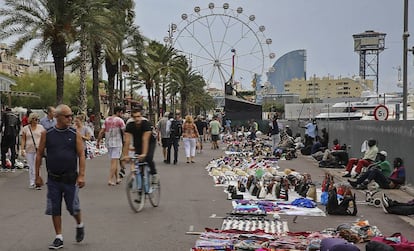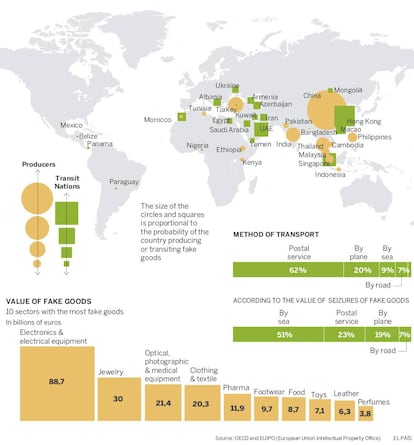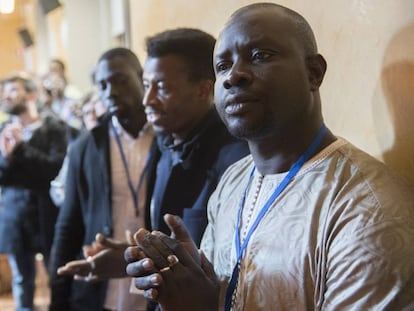Where do the world’s counterfeit goods come from?
OECD and EU study reveals manufacturing bases and distribution routes, highlights role of e-commerce


Where do fake designer goods come from? Who produces them? Which countries do they go through on their way to market? A report published Thursday by the Organisation for Economic Cooperation and Development (OECD) and the European Union Intellectual Property Office (EUIPO) seen by EL PAÍS shows that China is the main source of knock-off and pirated products sold around the world, while Hong Kong, the United Arab Emirates and Singapore are distribution points. The report also highlights the growing importance of e-commerce in the sale of these fake designer goods.
The report notes distribution hubs are often in countries with “weak governments and strong organized crime”
The report follows up on another study produced last year by both organizations which looked at the economic impact of fake goods. That research, based on data from customs seizures around the world, concluded that the business was worth €413 billion in 2013, equivalent to 2.5% of total global commerce. In the case of the EU, that figure rises to 5%. China and Hong Kong were identified as the origin of 80% of goods seized by the authorities.
In their latest report, the OECD and EUIPO have selected a range of the most-commonly copied goods, divided into 10 categories, representing 63% of the total fake market: food, pharmaceuticals, perfumes and cosmetics, leather goods and bags, clothing and textiles, shoes, jewelry, electronic and electrical goods, optical and photographic devices, and toys.

Based on an assessment of the industrial capacity of “countries of origin,” China emerges as the main producer of nine out of 10 of the fake goods categories, with India leading the field in pharmaceuticals, most of which go to Africa, while the developed world is the destination for electronic goods.
Turkey is identified as among the leading players in the production of fake goods, particularly leather articles, foodstuffs and cosmetics, which are distributed by road throughout the EU.
A glance at the map accompanying this article provides a general idea of the movement of fake goods. Most are produced in China, India and Thailand and head west via Hong Kong, Macao and Singapore, as well as through ports in Ukraine and Albania or Morocco and Egypt, the United Arab Emirates, Kuwait and Saudi Arabia. Panama is an important distribution point for the United States.
China and Hong Kong were identified as the origin of 80% of goods seized by the authorities
The report notes that some distribution hubs are in countries with “weak governments and a strong organized crime presence.”
Criminal gangs are increasingly turning to mail and courier services to get their counterfeit goods to market, notes the report: 62% of seizures between 2011 and 2013 had been sent through the mail. Hong Kong, Singapore and the United Arab Emirates were identified as transit points where fake goods are repackaged from containers. Sending parcels through the post reflects “the growing importance of the internet and e-commerce in international trade,” notes the report.
The authors advises authorities to focus on the issue of postal packages and free trade zones, which are beyond the reach of customs authorities and are often used “to hide the origin of shipments” and to repackage and redistribute counterfeit goods and to create companies to “support illegal operations.”
English version by Nick Lyne.
Tu suscripción se está usando en otro dispositivo
¿Quieres añadir otro usuario a tu suscripción?
Si continúas leyendo en este dispositivo, no se podrá leer en el otro.
FlechaTu suscripción se está usando en otro dispositivo y solo puedes acceder a EL PAÍS desde un dispositivo a la vez.
Si quieres compartir tu cuenta, cambia tu suscripción a la modalidad Premium, así podrás añadir otro usuario. Cada uno accederá con su propia cuenta de email, lo que os permitirá personalizar vuestra experiencia en EL PAÍS.
¿Tienes una suscripción de empresa? Accede aquí para contratar más cuentas.
En el caso de no saber quién está usando tu cuenta, te recomendamos cambiar tu contraseña aquí.
Si decides continuar compartiendo tu cuenta, este mensaje se mostrará en tu dispositivo y en el de la otra persona que está usando tu cuenta de forma indefinida, afectando a tu experiencia de lectura. Puedes consultar aquí los términos y condiciones de la suscripción digital.










































